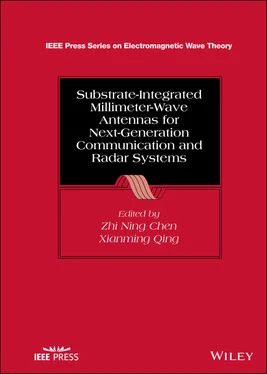4 Beam‐Scanning Functionality: Due to the need of high gain, the beamwidth of the radiation pattern is narrow so that it is difficult to achieve a wide coverage, but it is easy for the radiation to be blocked by unwanted obstacles. To keep propagation links unbroken, the functionality of beam‐scanning of antennas is one solution. Therefore, much more expensive and complicated antenna designs are necessary.
From the fabrication and measurement point of view:
1 High‐End Material and Tight Tolerance Fabrication: To keep low the ohmic loss caused in materials, high‐end materials, usually at higher prices, must be used. For instance, FR4 is replaced by more expensive but higher performance Rogers or ceramic or liquid crystal polymer (LCP). Meanwhile, due to the shorter wavelengths at higher frequencies, higher‐precision fabrication processes are needed to achieve results within the acceptable tolerance. For example, conventional printed circuit board (PCB) process can guarantee a tolerance of 0.2 mm, which is 0.2% wavelength at 3 GHz but 4% wavelength at 60 GHz!
2 Testing Setup: There have been many antenna testing setups up to 40 GHz in the market and laboratories. It is necessary to upgrade the setups and system for the antenna test for the frequencies higher than 40 or 67 GHz. Expensive frequency up‐converter heads are necessary for the frequency extension of such mmW systems. For the measurement of impedance or S‐parameters, high‐quality but expensive connectors and cables must be used to keep the insertion loss acceptable. In addition, the on‐wafer mmW antenna measurement must be carried out using precise and expensive probes where the measurement is usually conducted on expensive specific probe stations. For the measurement of radiation performance, due to the lack of link budget and the concern of testing environments, it is necessary to design the setup by customizing the mechanical structures with high‐precision location and orientation.
In short, the design of mmW antennas faces much more lossy, complicated, and costly issues than those at lower microwave frequencies. The research and development activities of mmW antenna technology should be done by taking all such unique challenges into account.
1.5 Briefing of State‐of‐the‐Art Millimeter Wave Antennas
From an antenna operation point of view, mmW antennas can be any type of radiators, such as wire, aperture, slot, microstrip, reflector, and Lens as shown in Figures 1.2, 1.3, and 1.4. Also the radiators can be arranged as arrays to enhance their radiating performance and achieve more functionalities. However, due to the unique challenges caused by their physically short wavelengths, namely 1 mm at 300 GHz to 10 mm at 30 GHz in free space as mentioned above, some types of radiators are more suitable for mmW antenna designs, as shown in the general discussion listed in Table 1.4. The discussion is based on the basic versions of all types of antenna designs. A variety of variations of the antenna have long been proposed for performance enhancement as presented in the References [21, 22].
Table 1.4 mmW antennas.
| Type of radiator |
Fabrication/Testing |
Performance/Applications |
Sketches |
| Aperture:HornOpen‐end waveguideWaveguide horn |
Easy fabrication and testBulky three‐dimensional geometry for metal structuresDifficult to be integrated with circuitsLow loss for air‐filled designPossibly fabricated using PCB aand LTCC bprocesses |
Moderate bandwidthHigh gainPoint to point linkStandard antennas in measurement systems |
Figure 1.2 |
| Microstrip patch |
Easy fabrication and testFlat and low‐profile geometryLossy at high frequenciesWide feeding stripsConformal configurationEasy to form arraysEasy to be integrated with circuitsEasy to be fabricated using PCB and LTCC processes |
Narrow bandwidthLow gainBroadside radiationWide applications |
| Slot:On groundOn cavityOn waveguide |
Easy fabrication and testFlat geometryEasy to form arraysConformal geometryDifficult to be integrated with circuits |
Narrow bandwidthLow gainBroadside radiation |
Figure 1.3 |
| Reflector:CornerFlat planeCurved plane |
Not easy fabrication and testBulky and three‐dimensional geometry with feedNot easy to form arraysDifficult to be integrated with circuits |
Wide bandwidthUltra‐high gainDirectional radiation |
Figure 1.4 |
| Lens:LuneburgConvex‐planeConcave‐planeConcave‐concaveConvex‐concaveConvex‐concaveConvex‐convex |
Not easy fabrication but easy testBulky, heavy and three‐dimensional geometry with feedNot easy to form arraysDifficult to be integrated with circuits |
Wide bandwidthUltra‐high gainDirectional radiation |
| Wires and their variations on substrate |
Easy fabrication and testFlat and low‐profile geometryLossy at high frequenciesWide feeding stripsConformal configurationEasy to form arraysEasy to be integrated with circuitsEasy to be fabricated using PCB and LTCC processes |
Moderate bandwidthLow gainBroadside/endfire radiation |
|
aPCB: printed circuit board.
bLTCC: low‐temperature co‐fired ceramic.
Also the antennas can be categorized into two classes based on physical geometry: flat/planar and three‐dimensional structures. For high‐gain applications, which are always required for mmW systems as mentioned previously, three‐dimensional designs such as reflector and lens antennas are perfect options if there is no space and installation constraints; the large‐scale arrays of planar elements such as microstrip antenna arrays and slot antenna arrays usually suffer from the difficulty to form the large‐scale feeding network in a limited physical space and high loss caused in the feeding networks.
As an alternative, a technique of laminated waveguides on PCB substrate was invented [23, 24], which is to some degree considered the extension of the work based on post‐rod to form air‐waveguides [25]. Later the structure was comprehensively studied and named as substrate integrated waveguide (SIW) and widely applied in mmW antenna designs [26, 27], where an electromagnetic waveguiding structure is constructed by the two walls formed by two arrays of metalized vias. The spacing between the adjacent vias must meet the criteria to stop the leak of wave propagating in the structure. Such a substrate‐integration technology provides much flexibility for waveguide designs and relevant antenna designs, in particular, at mmW bands.
1.6 Implementation Considerations of Millimeter Wave Antennas
At mmW bands, the integration of antennas and substrate by using a multilayer substrate process are desired for planar or flat design of system boards. The substrate integrated antenna (SIA) can be fabricated exactly as a conventional circuit as for printed circuits on layered boards, where the antennas become part of circuit boards or package of integrated circuits. Such integration greatly reduces the loss caused by the connection between the circuits and the antennas, miniaturizes the size of the system, lowers the fabrication cost, and increases the robustness of the system without additional installation of antennas. The integration of the antennas on the substrate is critically determined by fabrication including the selection of substrate materials and the applicable fabrication process.
1.6.1 Fabrication Processes and Materials of the Antennas
With the shorter operating wavelengths in the order of a millimeter, the fabrication of mmW antennas needs a tolerance usually tighter than microwave to achieve the desired performance. For example, for a straight thin half‐wave dipole antenna operating at 60 GHz, the overall length of the antenna is about 2.5 mm. The acceptable fabrication tolerance is typically 0.2% wavelength, namely 0.05 mm, which nearly reaches the limit of the conventional commercial PCB process. The tighter tolerance of fabrication is needed if the antennas and feeding network are printed on the PCBs with the relative dielectric constant larger than unit. Therefore, the selection of fabrication for mmW antennas with feeding networks is more critical than that at lower microwave bands, not only because of the tolerance but also costs including processing, materials, and assembling.
Читать дальше












